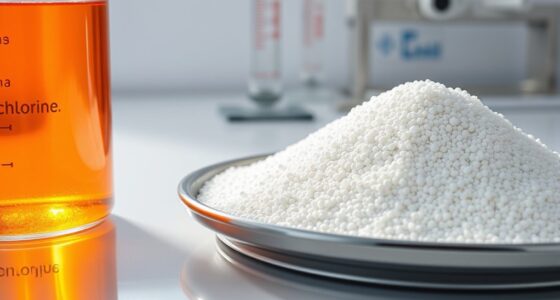Using CO₂ for pH control in pools lets you precisely and eco-friendly maintain stable water balance. It dissolves easily, forming carbonic acid that lowers pH gradually, reducing the risk of overcorrection common with traditional chemicals. Installation involves a CO₂ tank, regulator, and pH sensors for continuous adjustments. If you want to learn how to set up, monitor, and troubleshoot this system effectively, keep exploring this effective and sustainable pH management method.
Key Takeaways
- CO₂ dissolves in pool water to form carbonic acid, naturally lowering pH levels for precise control.
- Proper equipment like a CO₂ tank, regulator, and pH sensor is essential for safe, effective injection.
- CO₂ offers stable pH regulation, reducing the need for traditional acids and decreasing chemical handling risks.
- Regular monitoring and calibration ensure consistent pH balance and prevent overcorrection or system malfunctions.
- Using CO₂ is an eco-friendly, cost-effective method that enhances water quality and minimizes chemical waste.
Understanding the Role of Ph in Pool Water Chemistry

pH plays a crucial role in maintaining healthy pool water by balancing acidity and alkalinity. When the pH level is just right—typically between 7.2 and 7.8—you help prevent problems like cloudy water, algae growth, and skin irritation. If the pH is too low, your water becomes acidic, which can corrode pool equipment and cause skin and eye irritation. On the other hand, if it’s too high, the water becomes alkaline, leading to scale formation and reduced sanitizer effectiveness. Maintaining proper pH guarantees your sanitizer works efficiently and keeps your water safe and clear. Regular testing helps you monitor these levels, so you can make adjustments before issues develop. Proper pH balance is essential for your pool’s overall health and your enjoyment. Additionally, using appropriate chemicals can help you effectively manage pH levels and ensure optimal water quality. To keep your pool in top condition, understanding the importance of pH control is vital for long-term water clarity and safety.
How Carbon Dioxide Regulates Ph Levels
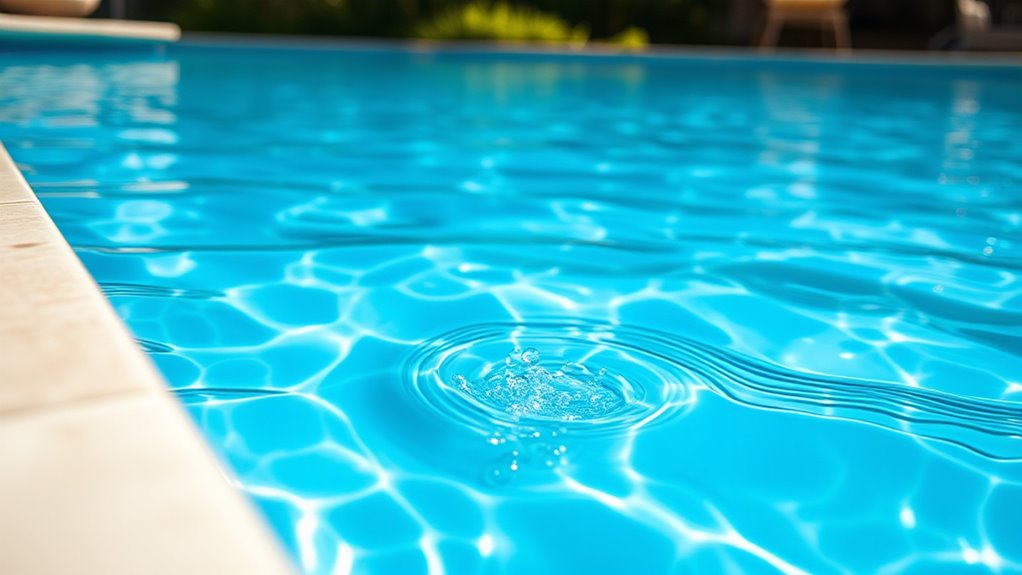
Carbon dioxide (CO₂) directly influences the pH of pool water by forming carbonic acid when it dissolves. This weak acid releases hydrogen ions, which lower the pH level. When you add CO₂, it reacts with water, creating carbonic acid that quickly adjusts the acidity. Because CO₂ can be precisely injected into the pool, you gain fine control over pH fluctuations. As pH drops, the water becomes more acidic, helping counteract rising alkalinity from other chemicals or environmental factors. This process is efficient and predictable, allowing you to maintain stable pH levels without sudden changes. By understanding how CO₂ interacts with water, you can use it effectively to keep your pool’s pH balanced, ensuring better water quality and comfort for swimmers. Proper injection techniques are essential for achieving consistent results and avoiding overcorrection.
Comparing Co₂ to Traditional Ph Adjustment Methods

While CO₂ offers precise control over pH levels by forming carbonic acid, traditional methods like adding acids or bases remain common choices for pool owners. These methods are straightforward but can cause rapid pH swings if not carefully managed. In contrast, CO₂ provides a more stable adjustment, reducing the risk of overshooting. Techniques in sound design include digital sound synthesis and layering, which can be applied metaphorically to adjusting chemical levels for more nuanced control. Advantages of CO₂ include: – More consistent pH regulation – Fewer chemical handling risks – Reduced chemical consumption over time – Easier automation and monitoring. Additionally, tuning principles such as gradual adjustments help maintain stable chemical balances. However, traditional acids like muriatic acid are often cheaper upfront and require less specialized equipment. Your choice depends on balancing investment, ease of use, and desired control. CO₂ systems suit those seeking precision and long-term stability, while traditional methods may appeal to budget-conscious pool owners.
Equipment Needed for CO₂ Injection Systems
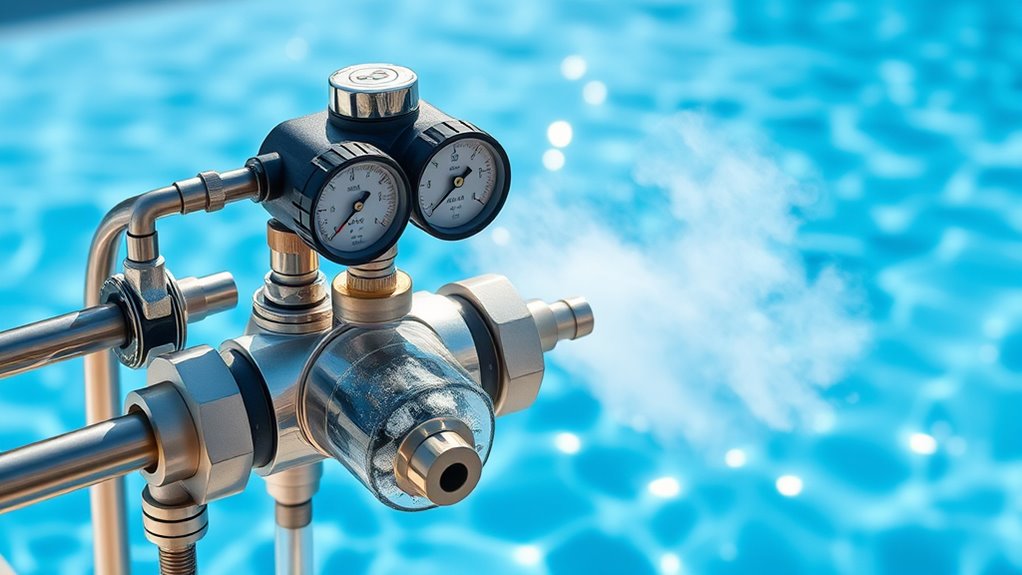
To establish a CO₂ injection system for your pool, you’ll need specific equipment to guarantee accurate and safe operation. First, you’ll require a CO₂ tank, which stores the gas under pressure. Connect it to a pressure regulator to control the flow rate and maintain safe operating pressure levels. A solenoid valve is essential for automated control, allowing you to turn CO₂ on or off remotely or based on pH readings. You’ll also need injection tubing or diffusers to evenly distribute CO₂ into the water. A pH controller or sensor is vital for monitoring the water’s pH level and providing feedback to the system. Additionally, incorporating precise calibration ensures the system maintains accurate pH adjustments over time. Regular calibration helps in maintaining the system’s accuracy and reliability, preventing over- or under-dosing of CO₂. This process is supported by understanding performance tuning principles, which can optimize system efficiency and effectiveness. Moreover, integrating emotional triggers into your system’s operation, such as alerts or visual indicators, can enhance user confidence and engagement. Lastly, make sure you have secure mounting brackets and safety devices, like pressure relief valves, to prevent accidents and ensure reliable operation.
Step-By-Step Guide to Setting up a Co₂ Ph Control System
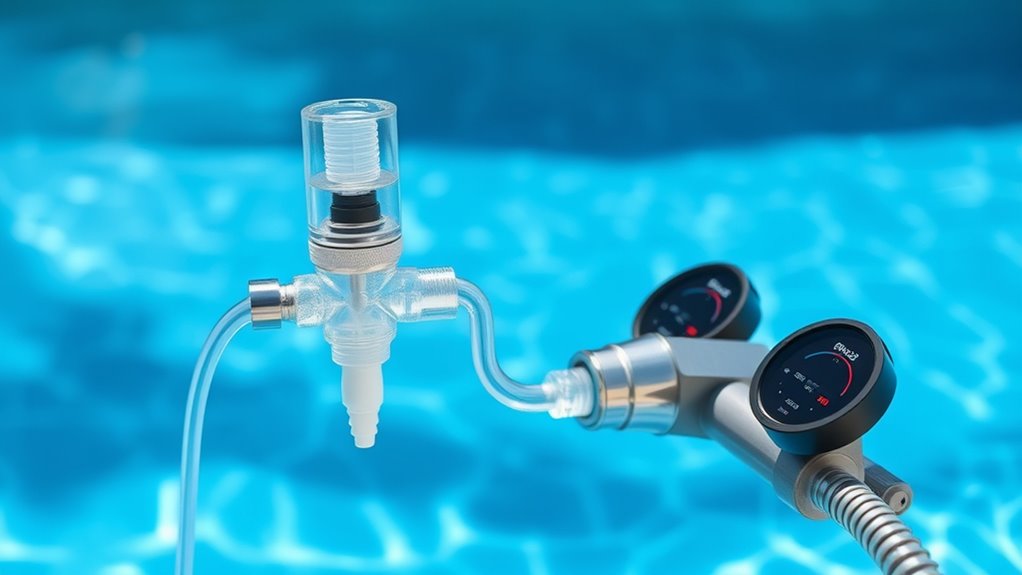
Setting up a CO₂ pH control system begins with installing the main components in a safe and accessible location. Verify the CO₂ cylinder, regulator, and pH controller are close to your pool equipment. Secure the cylinder upright to prevent leaks or accidents. Connect the regulator to the CO₂ tank, then link it to the injection point. Adjust the regulator to the recommended pressure. Finally, calibrate the pH controller according to the manufacturer’s instructions. It is also essential to properly maintain the system to ensure consistent pH levels and prevent malfunctions. Regular inspections help identify potential leaks or malfunctions early, ensuring reliable pH control, and understanding the types of cookies used can help optimize your online experience and privacy. To achieve optimal results, it is beneficial to understand how different chemical adjustments can impact pool pH levels and system performance. Additionally, familiarizing yourself with system components can aid in troubleshooting and maintenance.
Monitoring and Maintaining Optimal Ph With Co₂

Once you’ve installed your CO₂ pH control system, consistent monitoring is key to maintaining ideal water chemistry. You should regularly check your pool’s pH levels using a reliable test kit or digital meter. Keep a log of your readings to identify trends and determine if adjustments are needed. Your CO₂ system may require fine-tuning based on factors like bather load, weather, and chemical balance. Always monitor for signs of pH imbalance, such as cloudy water or scaling. If the pH drifts too low or high, adjust your CO₂ flow accordingly to restore balance. Remember, precise control is essential; over- or under-dosing can lead to issues. Regular testing and adjustments ensure your pool water remains comfortable, clear, and properly balanced. Additionally, understanding the interconnectedness of natural elements can help you better appreciate the importance of maintaining optimal water chemistry. Being aware of how chemical balance influences other water quality parameters allows for a more comprehensive approach to pool maintenance. Proper calibration of your CO₂ system, based on air quality and other environmental factors, can further optimize your pH control, especially considering how environmental conditions impact chemical reactions in water. Regularly inspecting your system’s components and ensuring proper system functionality can prevent unexpected pH fluctuations.
Advantages of Using Co₂ for Pool Ph Management
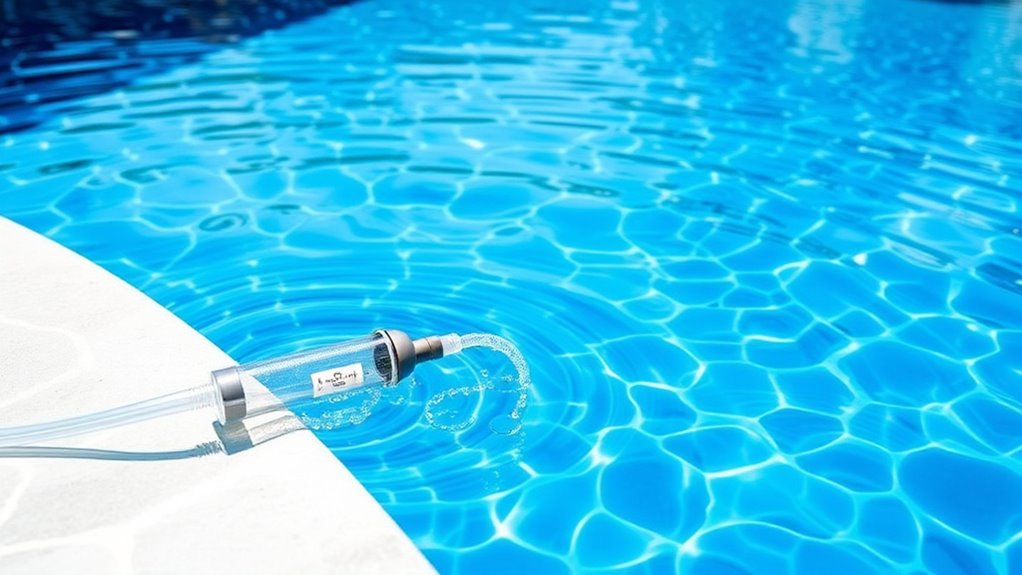
Using Co₂ for pH management offers precise control, so you can maintain the ideal balance effortlessly. It also reduces the need for traditional chemicals, saving you money and effort. Plus, Co₂ is an eco-friendly option that minimizes environmental impact.
Precise Ph Adjustment
Because of its ability to dissolve easily and react predictably, CO₂ provides extremely precise control over your pool’s pH levels. This means you can fine-tune your water chemistry with accuracy, avoiding sudden swings or overcorrections. Chemical stability ensures that CO₂’s natural buffering capacity helps maintain stable pH levels, reducing the need for frequent adjustments. Its controlled injection allows you to target specific pH ranges, ensuring ideal water quality. You’ll experience fewer disruptions, leading to clearer water and a more comfortable swimming environment. Additionally, leveraging AI safety measures can help optimize the monitoring and regulation of chemical levels for increased reliability. Incorporating precious metals in water treatment can further enhance system stability and chemical balance, providing an extra layer of chemical precision to your pool management. Moreover, understanding sound healing science can inspire innovative approaches to creating calming environments around your pool area, enhancing overall relaxation.
Reduced Chemical Usage
By precisely controlling your pool’s pH with CO₂, you can considerably reduce the amount of chemical treatments needed. Lower chemical use means fewer harsh chemicals in your water, which benefits your skin, eyes, and equipment. It also minimizes the need for frequent balancing, saving you time and money. Implementing CO₂ systems ensures consistent pH levels, reducing fluctuations that often require additional chemicals. Here’s a quick comparison:
| Chemical Type | Typical Usage per Month | Environmental Impact |
|---|---|---|
| Chlorine | 10-15 gallons | High (chlorinated waste) |
| pH Up/Down | 5-10 gallons | Moderate |
| CO₂ | 1-2 tanks | Low |
| Salt | Varies | Moderate |
| Algaecides | 2-4 gallons | Low |
This approach not only cuts chemical consumption but also promotes a cleaner, safer swimming environment.
Eco-Friendly Solution
Switching to CO₂ for pH management offers a substantially more eco-friendly alternative to traditional chemical methods. Unlike harsh chemicals, CO₂ reduces the release of harmful byproducts into your environment. It’s a cleaner choice that minimizes chemical runoff and potential water contamination. By choosing CO₂, you’re supporting sustainability and reducing your pool’s carbon footprint. Plus, it helps maintain balanced water chemistry without introducing synthetic substances.
- Produces fewer chemical waste products
- Lowers the risk of water pollution
- Reduces reliance on hazardous chemicals
- Supports eco-conscious pool maintenance
This switch not only benefits the environment but also simplifies your pool care routine, making it safer for swimmers and easier on your local ecosystem.
Potential Challenges and Troubleshooting Co₂ Ph Control
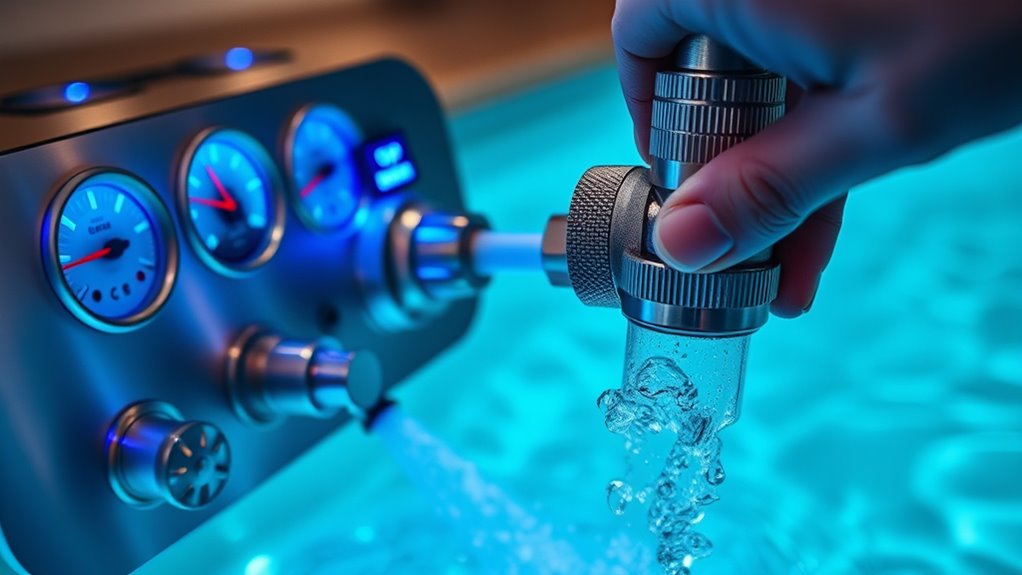
While CO₂-based pH control offers many advantages, it can present several challenges that require careful troubleshooting. One common issue is inconsistent pH levels, often caused by improper sensor calibration or malfunctioning regulators. If the pH drifts unexpectedly, check the CO₂ supply line for leaks or blockages. Additionally, fluctuations might result from poorly maintained equipment or incorrect system settings. Another challenge is overcorrection, where too much CO₂ lowers pH excessively. To prevent this, monitor pH levels regularly and adjust the CO₂ injection accordingly. If problems persist, ensure your sensors are clean and calibrated correctly. Regular maintenance of valves, gauges, and regulators is crucial to avoid malfunctions and maintain stable pH levels, ensuring your pool stays balanced and safe.
Ensuring Safety and Environmental Benefits of CO₂ Use

Using CO₂ for pH control enhances safety and offers notable environmental benefits when managed properly. It reduces the need for harsh chemicals like muriatic acid, lowering chemical exposure risks. Proper handling minimizes leaks and ensures safe operation. Additionally, CO₂ is a greenhouse gas that can be captured and reused, supporting sustainability efforts. To maximize safety and environmental advantages, consider these points:
- Regularly monitor CO₂ levels to prevent over-pressurization
- Use certified equipment designed for safe CO₂ handling
- Train staff on proper storage and emergency procedures
- Opt for CO₂ sources with minimal environmental impact
Frequently Asked Questions
How Does Co₂ Impact the Overall Water Chemistry Beyond Ph?
You might wonder how adding CO₂ affects your pool water beyond just adjusting pH. When CO₂ dissolves, it forms carbonic acid, which helps stabilize pH levels. This process also slightly lowers alkalinity and can reduce calcium scaling. Additionally, CO₂ can keep chlorine levels more stable and prevent corrosion. Overall, CO₂ improves water balance, making your pool safer, clearer, and easier to maintain.
Can Co₂ Be Used Effectively in Saltwater Pools?
You might think saltwater pools are trouble-free, but managing pH remains tricky. Ironically, Co₂ works just as well here as in traditional pools, helping you keep pH balanced without harsh chemicals. You’ll find it effective because it dissolves easily, lowers pH naturally, and minimizes corrosion. So, yes, you can confidently use Co₂ in saltwater pools, making maintenance simpler while maintaining crystal-clear water.
What Is the Typical Lifespan of a Co₂ Injection System?
You’re wondering about the typical lifespan of a Co₂ injection system. Generally, these systems last around 5 to 10 years with proper maintenance. Factors like water quality, usage frequency, and regular servicing can impact their longevity. To guarantee your system works efficiently, check for leaks, clean the components, and replace any worn parts as needed. Regular upkeep helps extend the lifespan and keeps your pool’s pH balanced.
Are There Any Regulatory Restrictions on Using Co₂ in Pools?
Imagine sailing through waters governed by unseen rules. You might wonder if there are hidden currents or restrictions that could steer you off course. Similarly, regulations on using Co₂ in pools vary by location. You need to verify local health and safety laws, as some areas might limit or require specific handling of gases. Staying informed ensures you avoid obstacles and keep your pool safe and compliant.
How Does Co₂ Influence Chlorine Effectiveness in Pool Water?
You might wonder how Co₂ affects chlorine’s effectiveness in pool water. When you add Co₂, it lowers the pH, making the water more acidic. This pH shift can reduce chlorine’s disinfectant power because chlorine works best in a pH range of 7.2 to 7.8. By controlling pH with Co₂, you help maintain ideal chlorine efficiency, ensuring your pool stays clean and safe.
Conclusion
Using CO₂ for pH control offers an eco-friendly and cost-effective way to keep your pool balanced. Did you know that CO₂ can reduce chemical usage by up to 30%, making your pool safer and more environmentally friendly? With proper setup and monitoring, you’ll enjoy clear, balanced water while minimizing chemical impact. Embrace CO₂ pH regulation and experience simpler, greener pool maintenance that benefits both you and the planet.





